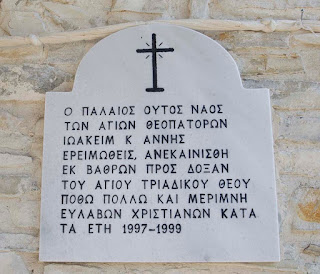It is located near Klavdia, a little before the larger chapel of Panagia stazousa. It was built on top of an ancient 11th century chapel.
Photography from nature and sight-seeing in Cyprus. Note I am willing to sell photos, If anyone is interested drop me an e-mail
counter
Τετάρτη 15 Δεκεμβρίου 2021
St Ioakim and anna chapel at Klavdia
Τετάρτη 1 Δεκεμβρίου 2021
Asprogia mosque
The Asprogia Mosque is situated on the main road between Kannaviou Village and Pano Panagio Village in the hills above the Ezousa Valley and close to Asprogia Village in the province of Paphos.
The Mosque is in reasonable condition considering no modernisation work or re-construction work has been carried out to it.
Κυριακή 14 Νοεμβρίου 2021
Panagia stazousa at Pyrga
Panagia Stazousa is a Medieval monastery located west of Larnaka between the villages of Pyrga and Klavdia.
It was built by the Franks at the beginning of the 14th century in the early Gothic architectural style.
The monastery was initially staffed by Latin Monastic Orders but later during the Turkish occupation it was abandoned and destroyed by several fires.The legend says that a smaller church preexisted at the location. A wealthy French lady, probably royal, suffering from hemorrhage visited the area. As she entered the church and kissed the icon of Virgin Mary, she was miraculously cured.
After that incident she founded at the place the bigger gothic church which is dedicated it to Virgin Mary, Zoodohos Pigi meaning the Life Giving Spring. Local people named her “Stazousa” from the Greek verb “stazo”, meaning dripping.
Today the monastery belongs to Stavrovouni and is staffed by only one monk. In the recent years the church and part of the cell complex have been completely renovated by the Department of Antiquities of Cyprus.
xcavations in the area also revealed a spring of holy water as well as a small church dedicated to John the Baptist.
The church of Mary the Life giving Spring celebrates on the first Friday after the Orthodox Easter. On that day pilgrims from all villages of the area gather to attend the special service honor the day.
.
Κυριακή 31 Οκτωβρίου 2021
Παρασκευή 15 Οκτωβρίου 2021
Geology of Cyprus
Παρασκευή 1 Οκτωβρίου 2021
Local archaeological Kourion museum part 1
Kourion Archaeological Museum is housed in a traditional building that was once the private residence of the late George McFadden, Assistant Director of the University of Pennsylvania, who led extensive archaeological research at the ancient city of Kourion and its environs from 1934 -1953.
The museum opened in 1969 and consists of two exhibition halls that showcase finds from the nearby archaeological sites, including red polished ware of the Early Bronze age, pottery and golden jewellery of the Mycenaean era, and a large number of offerings from the nearby Sanctuary of Apollon Hylates.
The skeletal remains of inhabitants of the city who lost their lives in the 4th century earthquakes constitute one of the most impressive exhibits of the museum, and were found in situ in a Roman house.
| Region: | Lemesos (Limassol) |
| Address: | Episkopi village, 14km west of Lemesos on the road towards Pafos (Paphos) |
| GPS coordinates: | Lat: 34.669656 Lon: 32.901015 |
| Contact No: | Tel: +357 25 932 453 |
| Operating Hours: | Monday - Friday: 08:00 - 15:30 Closed on weekends. |
| Operating Period: | All year round. Closed on Public Holidays. |
| Entrance Fee: | €2,50 For organised groups consisting of more than 10 persons there is a 20% reduction on the entry fees. The Department of Antiquities can issue special entry cards for all its museums and ancient monuments: One (1) day entry cards - €8,50, three (3) day entry cards - €17,00, seven (7) day entry cards - €25,00. |
| Website: | www.mcw.gov.cy/da |
| Opening and closing times as well as entrance fees, are subject to alterations without notice. Visitors are advised to check before visiting. Sepulchral reliefe-Limestone Cypro-archaic I period 750-600 BC Engraved plaque-Marble-Sanctuary of Apollo Hylates Roman period 3rd cent AD Dedicatory inscription to Apollo Hylates, by Claudianos' son of Thyllicos who was cured of his illness by the God. Bones from middle-aged man Lamp 4th century AD Torso of God Hypnos. Marble. Sanctuary of Apollon Hylates Roman period 30 BC Deer statuette Lamps |





















































